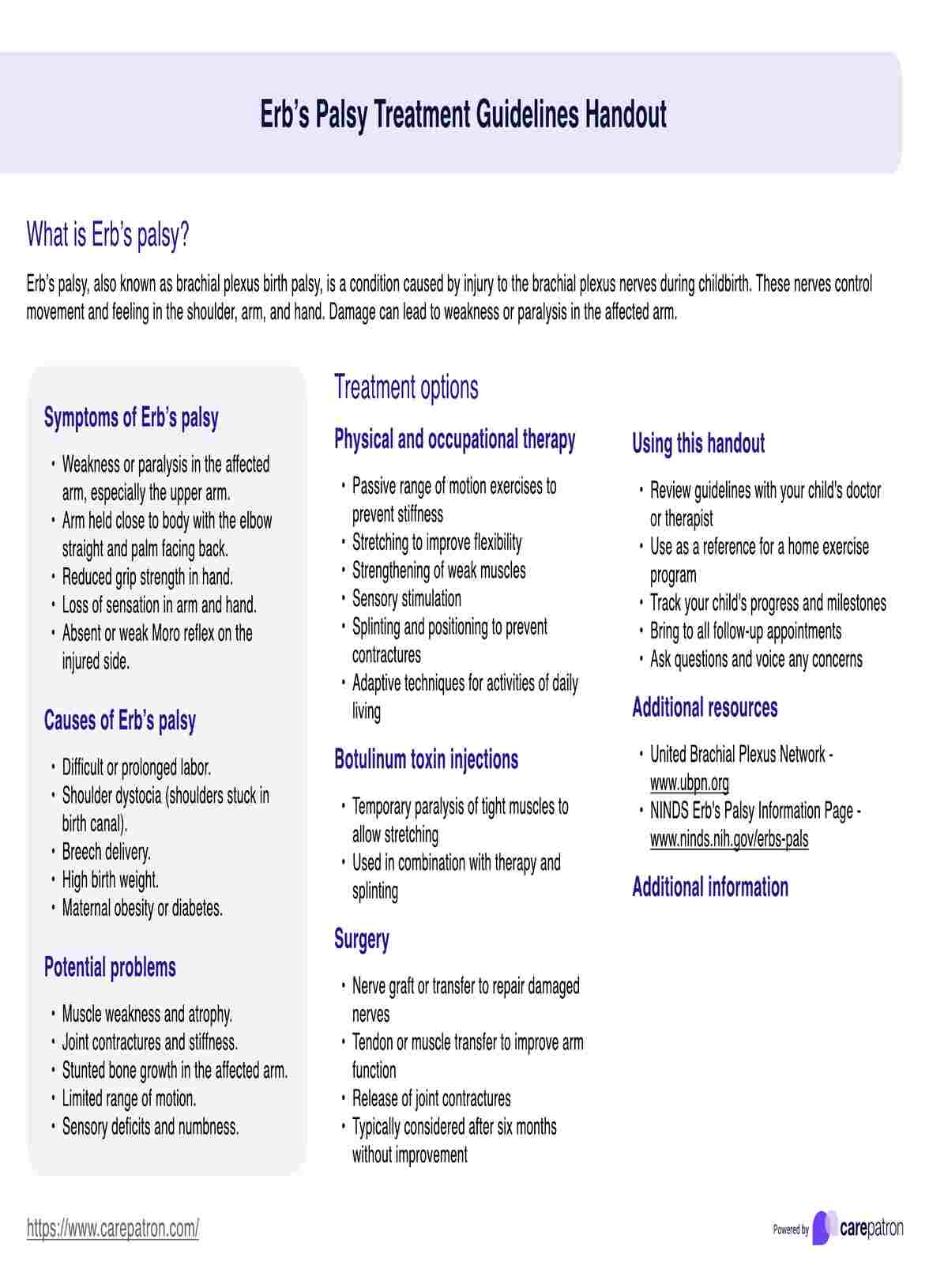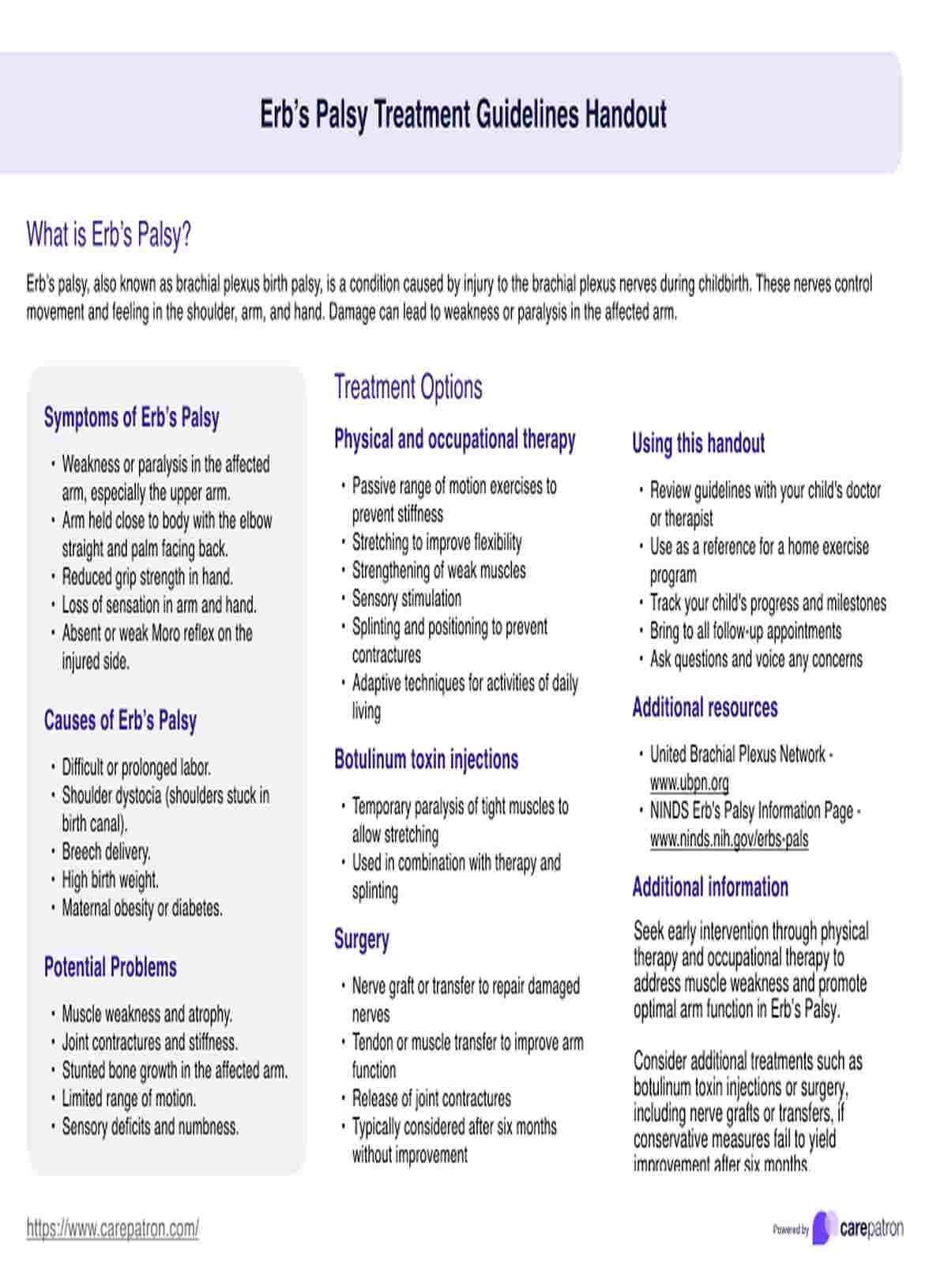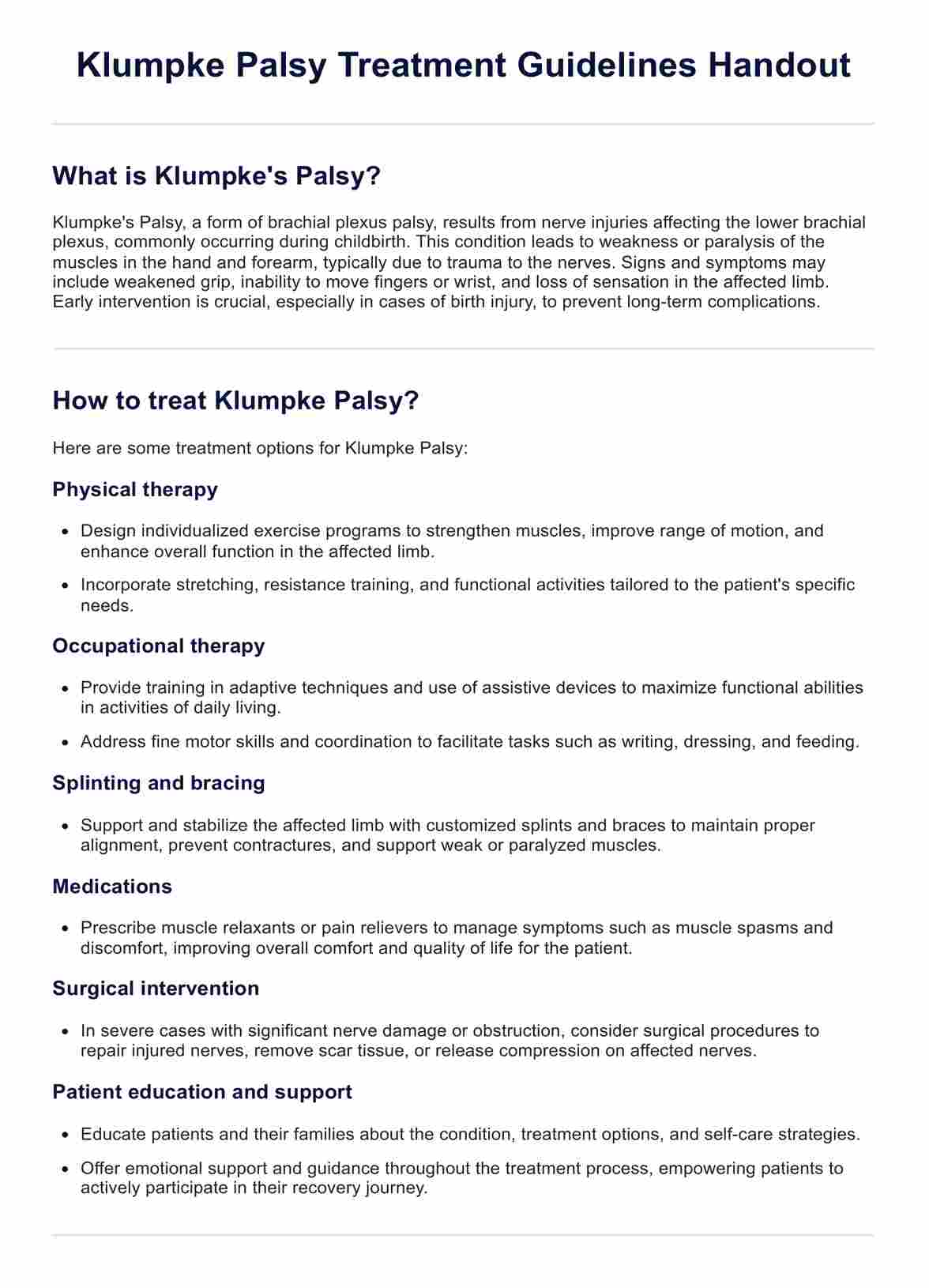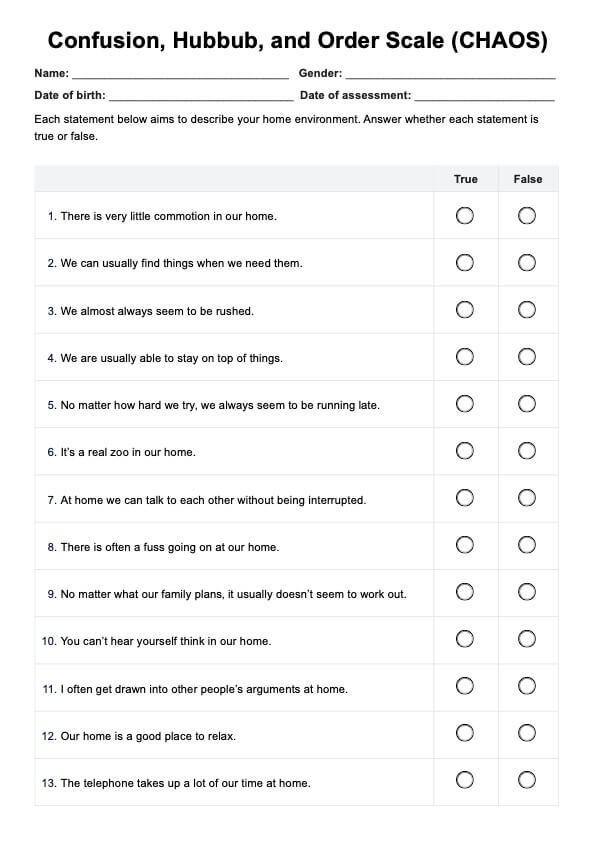Erb's Palsy Treatment Guidelines Handout
Learn essential information about Erb's palsy by downloading our Erb's Palsy Treatment Guidelines Handout. Use this handout to educate and support your patients.


What is Erb's palsy?
Erb's palsy, also known as a brachial plexus injury or birth palsy, is a condition resulting from injury to the brachial plexus nerves during childbirth. The brachial plexus is a network of nerves that provides movement and sensation to the shoulder, arm, and hand. When these nerves are damaged, they can cause weakness or paralysis in the affected arm.
Erb's palsy symptoms
The severity of symptoms varies based on nerve injury and the extent of damage to the brachial plexus nerves, ranging from mild cases that may resolve on their own to more severe injuries that can result in permanent impairment. The symptoms of Erb's palsy include the following:
- Weakness or paralysis in the affected arm
- Lack of movement in the shoulder, elbow, wrist, or hand
- The arm is held close to the body with the elbow straight
- Decreased grip strength in the hand
- Loss of sensation in the arm
Causes of this brachial plexus palsy
The main causes of Erb's palsy include:
- Shoulder dystocia: This occurs when the baby's shoulder becomes stuck behind the mother's pubic bone during delivery, requiring the head and neck to be pulled to the side.
- Difficult, prolonged labor: This is especially common with larger babies over 8-9 pounds (macrosomia).
- Breech delivery: When the baby is delivered feet-first, it puts pressure on the raised arms.
- Excessive pulling: Excessive pulling on the baby's head, neck, or shoulders by the doctor during a difficult delivery can stretch or tear the brachial plexus nerves.
- Maternal risk factors: These include obesity, diabetes, or an unusually shaped pelvis.
- Use of assistive delivery tools: Tools like forceps or vacuum extraction can cause undue pressure.
Potential problems this palsy may cause
Some of the potential long-term problems and complications caused by Erb's palsy include:
- Muscle weakness and atrophy: The affected arm may have decreased strength and muscle mass due to impaired nerve function, leading to significantly less muscle development than the unaffected arm.
- Contractures (tightening of muscles and joints): Tightening of the muscles, tendons, and joints can occur, limiting the range of motion. A common issue is a bent elbow due to a very tight joint, known as an elbow contracture.
- Impaired bone growth in the affected arm: Impaired nerve innervation can lead to stunted growth from the shoulder to the fingertips, making the affected arm noticeably smaller. Nerves influence growth and development so that the injured arm may grow more slowly.
- Reduced range of motion: Limited shoulder, elbow, wrist, and/or hand movement is common due to muscle weakness and contractures. The arm may lack the ability to straighten or rotate normally.
- Sensory deficits: Some loss of feeling or sensation in the arm, hand, and fingers may persist, with numbness in the arm increasing the risk of accidental burns or injuries.
Erb's Palsy Treatment Guidelines Handout Template
Erb's Palsy Treatment Guidelines Handout Example
How is Erb's palsy treated?
Erb's palsy is typically treated using a combination of nonsurgical and surgical approaches, depending on the severity of the injury and the infant's recovery progress. The main treatment options include:
Physical therapy and occupational therapy
Daily physical therapy is the primary conservative treatment, initiated as early as possible (within the first four weeks after birth) to maintain the range of motion, strengthen muscles, and prevent contractures. Occupational therapy focuses on improving hand and finger function for daily activities. Massage techniques and stretching can also be beneficial.
Splinting and positioning
Splints and proper positioning help prevent contractures and maintain the arm in a functional position.
Surgery
If there is no improvement after 3-6 months of conservative treatment, surgery may be recommended to repair damaged nerves. Surgical options include nerve grafts (using a donor nerve to repair a rupture), nerve transfers (reconnecting a healthy nerve to the injured one), and muscle/tendon transfers. For the best chance of functional recovery, surgery is typically performed within 6-9 months after birth.
What is an Erb's Palsy Treatment Guidelines Handout?
An Erb's Palsy Treatment Guidelines Handout is a concise document that outlines the critical information about Erb's palsy, its symptoms, causes, potential problems, and treatment options. It is a valuable resource for parents, caregivers, and healthcare professionals caring for a child with Erb's palsy.
The handout conveys information clearly and is organized, using simple language and bullet points to highlight important details. It may also include illustrations or diagrams to help readers better understand the condition and its management.
What is in an Erb's Palsy Treatment Guidelines Handout?
An Erb's Palsy Treatment Guidelines Handout typically contains the following critical information:
Definition and explanation of Erb's palsy
This section briefly describes Erb's palsy, a type of brachial plexus birth injury that results in weakness or paralysis in the affected arm due to nerve damage.
Symptoms of Erb's palsy
This part lists the common symptoms of Erb's palsy, including weakness, numbness, or paralysis in the affected arm, specific postures the arm may assume, and reduced grip strength and sensation in the hand.
Causes and risk factors
Here, the primary causes and risk factors for developing Erb's palsy are detailed, such as difficult or prolonged labor, shoulder dystocia, and breech delivery.
Potential complications
This section outlines the possible long-term problems and complications associated with Erb's palsy, including muscle weakness and atrophy, joint contractures, stunted bone growth, limited range of motion, and sensory deficits.
Treatment options
This part describes the various treatment approaches for Erb's palsy, including physical therapy, occupational therapy, splinting and positioning, surgery, and Botox injections.
Benefits of using this handout
The Erb's Palsy Treatment Guidelines Handout offers several advantages for both healthcare practitioners and families:
Provides a clear and concise overview of Erb's palsy and its management
This handout delivers essential information in a straightforward and easily understandable format, allowing practitioners to quickly convey key aspects of the condition and its treatment to parents and caregivers.
Helps parents and caregivers understand the condition and what to expect
The handout educates parents and caregivers by outlining the symptoms, causes, potential complications, and treatment options, helping them understand Erb's palsy better. This knowledge enables them to set realistic expectations and actively participate in their child's care and rehabilitation.
Promotes consistency in patient education and treatment planning
The standardized information in the handout ensures that all healthcare providers within a practice or medical team communicate a consistent message. This consistency helps avoid confusion and reinforces the treatment plan, making it easier for parents and caregivers to follow recommended guidelines.
Serves as a valuable reference for healthcare professionals
Practitioners can use the handout as a quick reference tool to guide family discussions, ensuring all critical points are covered. It also aids in coordinating care among different healthcare team members, enhancing overall treatment effectiveness and patient outcomes.
Commonly asked questions
Erb's palsy, a type of brachial plexus birth palsy, specifically affects the upper brachial plexus nerves, resulting in weakness or paralysis in the upper part of the affected arm. Other brachial plexus injuries can impact different parts of the nerve network, potentially affecting a broader range of motion and sensation.
Shoulder dystocia occurs when the baby's shoulders become lodged in the birth canal during delivery, putting excessive pressure on the brachial plexus nerves. This pressure can cause obstetric brachial plexus lesions, leading to neonatal brachial plexus palsy and resulting in weakness or paralysis of the affected arm.
While obstetric brachial plexus palsy primarily involves damage to the brachial plexus nerves, it does not directly affect the spinal cord. However, the injury occurs close to where these nerves exit the spinal cord, which can complicate the injury and affect the arm's movement and sensation.
Signs of a brachial plexus injury in a newborn, such as brachial plexus birth palsy, include limited movement or weakness in the affected arm, an arm held close to the body with the elbow straight, and a reduced grip in the hand. If these symptoms are observed, it is crucial to seek medical evaluation to determine the extent of the injury and appropriate treatment.








































































































